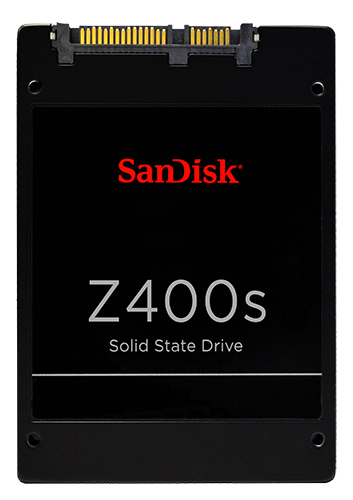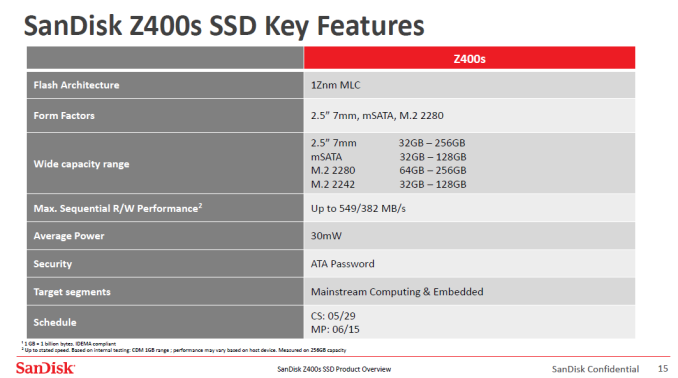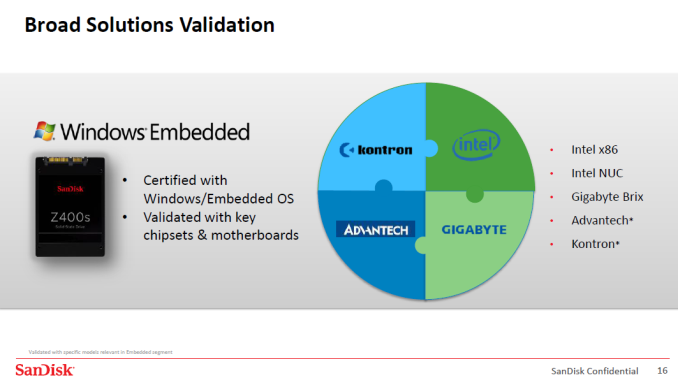SanDisk Releases Z400s SSD for Mainstream PCs & Embedded Applications
by Kristian Vättö on May 26, 2015 3:44 AM EST
With Computex only a week away, SanDisk is taking a head start today with the release of Z400s SSD. SanDisk is aiming to cater two different markets with the X400s, the first one being the traditional mainstream PC space where SanDisk is looking to bring low-capacity drives at an affordable price, and the other one is the embedded market that includes applications such as digital signage, point of sale and surveillance.
Embedded devices still rely heavily on hard drives because the upgrade cycles tend to be long and the cost of SSDs hasn't been low enough to attract interest over hard drives. Most embedded devices often have only one key function, which is why the market hasn't seen SSDs as a viable solution until recently when low-capacity SSDs have become cost competitive with hard drives. Because the applications don't typically need more than a few dozen gigabytes, SanDisk is offering the Z400s in capacities from 32GB to 256GB in a variety of form factors including M.2 and mSATA. The reason why SanDisk isn't offering any higher capacity options is because the average client SSD capacity is still well below 256GB (~180GB according to SanDisk's own research), so since the Z400s is aimed for the hard drive replacement crowd the company wanted to keep the available options as low cost as possible.
As usual, SanDisk isn't disclosing the controller inside the Z400s, but given SanDisk's history I would guess it's a 4-channel Marvell silicon, although I wouldn't be surprised to see a Silicon Motion or JMicron controller for further cost reductions (Marvell's controllers are relatively expensive compared to others). The Z400s turns out to be SanDisk's, and world's, first SSD to utilize 15nm NAND, which has certainly spent a long time in making. I posted a preliminary analysis on Toshiba-SanDisk's 15nm NAND in last August, but we'll know more once the drives ship and the die is put under a microscope. From what I have heard the supply of 15nm is still very limited, but we should see more products based on it in the coming months.
The Z400s has already been validated by a handful of key embedded PC manufacturers, including Intel's NUC and Gigabyte's Brix divisions that focus on small form factor PCs. That said, despite being focused on the embedded market the Z400s hasn't been validated for industrial use (large temperature scale, heavy vibration, humidity etc), so it's strictly for applications used in normal environments (e.g. a point of sale in a grocery store). While that somewhat limits the market, there are many applications that will certainly enjoy the benefits of higher reliability and performance that SSDs bring to the table. All in all, I don't really follow the embedded space enough to know how big the market is, but I do see it being a growing niche in the future. Given that SanDisk is an SSD-only company, it's logical for it to pursue smaller niches and markets that aren't overly populated yet because it can't rely on other operations for revenue growth (and due to SanDisk's recent stock performance, it's clear that the company needs to widen its revenue base).
The Z400s is entering mass production next month with availability being later in the summer. It will be available through the channel too, but since it's not exactly a retail product like the Ultra II SanDisk isn't publishing any pricing details at this point.












25 Comments
View All Comments
jjj - Tuesday, May 26, 2015 - link
I assume it's TLC?As for the controller, maybe it's the DRAMless Marvell 88NV1120 http://www.marvell.com/storage/assets/Marvell_88NV...
Would be interesting to see how that budget controller does.
jjj - Tuesday, May 26, 2015 - link
guess it's not TLC ,that slide lists it as MLC.bill.rookard - Tuesday, May 26, 2015 - link
I have a Sandisk SSD in my Asus laptop (UX-31) and recently had to replace a spinny drive which failed, so I went with a standard Sandisk 128Gb 2.5 SSD. Both have been sufficiently fast, and the replacement drive was quite affordable and performs quite well. This is the kind of SSD that an IT department could probably deploy without much issue and the bean counters would like it too with the affordable price.As mentioned, there are Ferarris and Toyotas. Nothing wrong with selling a lot of Toyotas.
romrunning - Tuesday, May 26, 2015 - link
Samsung's 850 Pro is a bit better performing than Sandisk's top retail model, but as a auto fan, it's nowhere near the scale of difference between a Ferrari (say, a road car like a 360 Modena) and a Toyota (say, a road car like a Camry). There's a massive difference in class, cost, performance, reliability, etc.If you want to go the car analogy route, it's more like the Toyota Camry vs Kia Optima or Honda Accord vs Hyundai Elantra.
close - Wednesday, May 27, 2015 - link
You took that to literal :). The point was a comparison between a top performer and an excellent daily driver. They both have the same performance when city driving and the only way you'll see some difference is taking them on the track. Which is something very few drivers do and even fewer need.Also, don't forget Volkswagen and Toyota own the likes of Audi, Bugatti or Lexus (of Audi R8, Bugatti Veyron and Lexus LFA fame :D).
romrunning - Wednesday, May 27, 2015 - link
:) - I know, I just couldn't resist.romrunning - Tuesday, May 26, 2015 - link
Excerpted from the write-up: "Given that SanDisk is an SSD-only company..."SanDisk isn't "SSD-only"; it is better to characterize them as a flash memory storage company. They have a bunch of memory cards as storage products in addition to their SSDs. As their Google link says: "SanDisk | Global Leader in Flash Memory Storage Solutions"
Perhaps what you could have said is "Given that SanDisk SSDs are primarily in retail channels..."
TheWrongChristian - Wednesday, May 27, 2015 - link
You wouldn't classify a solid state flash memory card as a Solid State Disk?romrunning - Wednesday, May 27, 2015 - link
Not in the normal sense that most think of when they hear the word "SSD". Even SanDisk themselves don't name their company as such. It's "Flash Memory Storage Solutions".trparky - Tuesday, May 26, 2015 - link
It would be better if they had a 500/512 GB model in the lineup as well for those people who want a little extra space for their installation.